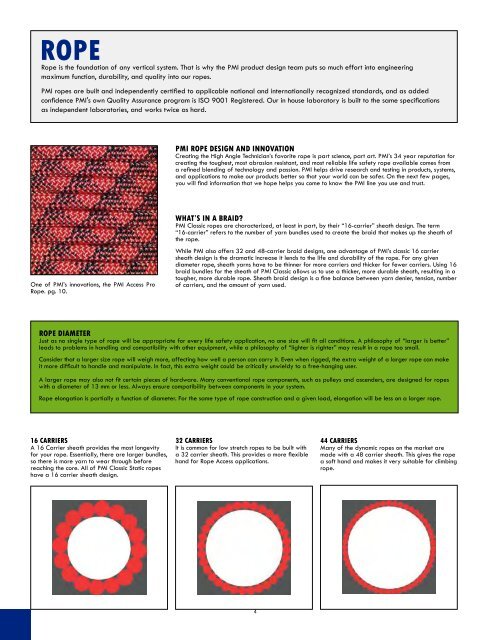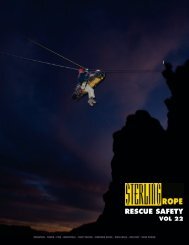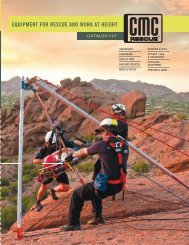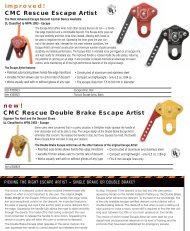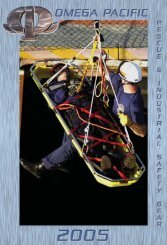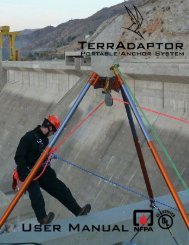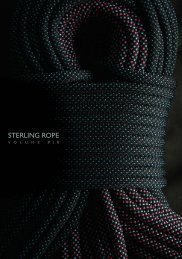ROPE - Rescue Consulting Canada
ROPE - Rescue Consulting Canada
ROPE - Rescue Consulting Canada
You also want an ePaper? Increase the reach of your titles
YUMPU automatically turns print PDFs into web optimized ePapers that Google loves.
<strong>ROPE</strong><br />
Rope is the foundation of any vertical system. That is why the PMI product design team puts so much effort into engineering<br />
maximum function, durability, and quality into our ropes.<br />
PMI ropes are built and independently certified to applicable national and internationally recognized standards, and as added<br />
confidence PMI's own Quality Assurance program is ISO 9001 Registered. Our in house laboratory is built to the same specifications<br />
as independent laboratories, and works twice as hard.<br />
PMI <strong>ROPE</strong> DESIGN AND INNOVATION<br />
Creating the High Angle Technician’s favorite rope is part science, part art. PMI’s 34 year reputation for<br />
creating the toughest, most abrasion resistant, and most reliable life safety rope available comes from<br />
a refined blending of technology and passion. PMI helps drive research and testing in products, systems,<br />
and applications to make our products better so that your world can be safer. On the next few pages,<br />
you will find information that we hope helps you come to know the PMI line you use and trust.<br />
One of PMI’s innovations, the PMI Access Pro<br />
Rope. pg. 10.<br />
WHAT’S IN A BRAID?<br />
PMI Classic ropes are characterized, at least in part, by their “16-carrier” sheath design. The term<br />
“16-carrier” refers to the number of yarn bundles used to create the braid that makes up the sheath of<br />
the rope.<br />
While PMI also offers 32 and 48-carrier braid designs, one advantage of PMI’s classic 16 carrier<br />
sheath design is the dramatic increase it lends to the life and durability of the rope. For any given<br />
diameter rope, sheath yarns have to be thinner for more carriers and thicker for fewer carriers. Using 16<br />
braid bundles for the sheath of PMI Classic allows us to use a thicker, more durable sheath, resulting in a<br />
tougher, more durable rope. Sheath braid design is a fine balance between yarn denier, tension, number<br />
of carriers, and the amount of yarn used.<br />
<strong>ROPE</strong> DIAMETER<br />
Just as no single type of rope will be appropriate for every life safety application, no one size will fit all conditions. A philosophy of “larger is better”<br />
leads to problems in handling and compatibility with other equipment, while a philosophy of “lighter is righter” may result in a rope too small.<br />
Consider that a larger size rope will weigh more, affecting how well a person can carry it. Even when rigged, the extra weight of a larger rope can make<br />
it more difficult to handle and manipulate. In fact, this extra weight could be critically unwieldy to a free-hanging user.<br />
A larger rope may also not fit certain pieces of hardware. Many conventional rope components, such as pulleys and ascenders, are designed for ropes<br />
with a diameter of 13 mm or less. Always ensure compatibility between components in your system.<br />
Rope elongation is partially a function of diameter. For the same type of rope construction and a given load, elongation will be less on a larger rope.<br />
16 CARRIERS<br />
A 16 Carrier sheath provides the most longevity<br />
for your rope. Essentially, there are larger bundles,<br />
so there is more yarn to wear through before<br />
reaching the core. All of PMI Classic Static ropes<br />
have a 16 carrier sheath design.<br />
32 CARRIERS<br />
It is common for low stretch ropes to be built with<br />
a 32 carrier sheath. This provides a more flexible<br />
hand for Rope Access applications.<br />
44 CARRIERS<br />
Many of the dynamic ropes on the market are<br />
made with a 48 carrier sheath. This gives the rope<br />
a soft hand and makes it very suitable for climbing<br />
rope.<br />
4


